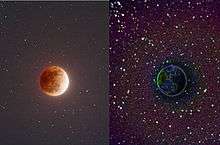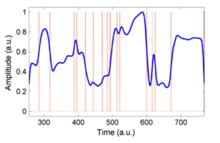Phase stretch transform







Phase stretch transform (PST) is a computational approach to signal and image processing. One of its utilities is for feature detection and classification.[1][2] PST is related to time stretch dispersive Fourier transform.[3] It transforms the image by emulating propagation through a diffractive medium with engineered 3D dispersive property (refractive index). The operation relies on symmetry of the dispersion profile and can be understood in terms of dispersive eigenfunctions or stretch modes.[4] PST performs similar functionality as phase contrast microscopy but on digital images. PST is also applicable to digital images as well as temporal, time series, data.
Operation principle
Here the principle is described in the context of feature enhancement in digital images. The image is first filtered with a spatial kernel followed by application of a nonlinear frequency-dependent phase. The output of the transform is the phase in the spatial domain. The main step is the 2-D phase function which is typically applied in the frequency domain. The amount of phase applied to the image is frequency dependent with higher amount of phase applied to higher frequency features of the image. Since sharp transitions, such as edges and corners, contain higher frequencies, PST emphasizes the edge information. Features can be further enhanced by applying thresholding and morphological operations. PST is related to warped (anamorphic) stretch transform, another computational algorithm inspired by optical physics and one that performs nonuniform sampling and sparse coding.
Applications
PST has been used for edge detection in biomedical images and synthetic aperture radar (SAR) image processing.[5][6]
The PST function can also be performed on 1D temporal waveforms in analog domain to reveal transitions and anomalies in real time.[4]
Open source code release
On February 9, 2016, a UCLA Engineering research group has made public the computer code for PST algorithm that helps computers process images at high speeds and “see” them in ways that human eyes cannot. The researchers say the code could eventually be used in face, fingerprint and iris recognition for high-tech security, as well as in self-driving cars’ navigation systems or for inspecting industrial products. The code is available for free download on two open source platforms, Github [7] and Matlab Files Exchange.[8] It is however provided for research purposes only and a license must be obtained for any commercial applications. The software is protected under a US patent.
See also
- Time stretch analog-to-digital converter
- Time stretch dispersive Fourier transform
- Anamorphic stretch transform
- Edge detection
- Feature detection
References
- ↑ M. H. Asghari, and B. Jalali, "Edge detection in digital images using dispersive phase stretch," International Journal of Biomedical Imaging, Vol. 2015, Article ID 687819, pp. 1-6 (2015).
- ↑ M. H. Asghari, and B. Jalali, "Physics-inspired image edge detection," IEEE Global Signal and Information Processing Symposium (GlobalSIP 2014), paper: WdBD-L.1, Atlanta, December 2014.
- ↑ Y. Han and B. Jalali, "Photonic time-stretched analog-to-digital converter: fundamental concepts and practical considerations," Journal of Lightwave Technology 21, 3085 (2003)
- 1 2 B. Jalali and A. Mahjoubfar, "Tailoring Wideband Signals With a Photonic Hardware Accelerator," Proceedings of the IEEE, Vol. 103, No. 7, pp. 1071-1086 (2015).
- ↑ M. H. Asghari, C. Clemente, B. Jalali, and J. Soraghan, “Synthetic aperture radar image compression using discrete anamorphic stretch transform,” IEEE Global Signal and Information Processing Symposium (GlobalSIP 2014), paper: WsBD-P.7, Atlanta, December 2014.
- ↑ C. V. Ilioudis, C. Clemente, M. H. Asghari, B. Jalali, and J. Soraghan, “Edge detection in SAR images using Dispersive Phase Stretch Transform,” submitted to 2nd IET International Conference on Intelligent Signal Processing, London, 2015
- ↑ https://github.com/JalaliLabUCLA/Image-feature-detection-using-Phase-Stretch-Transform
- ↑ https://www.mathworks.com/matlabcentral/fileexchange/55330-jalalilabucla-image-feature-detection-using-phase-stretch-transform